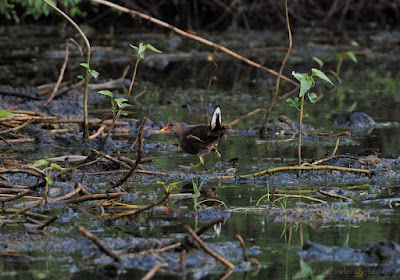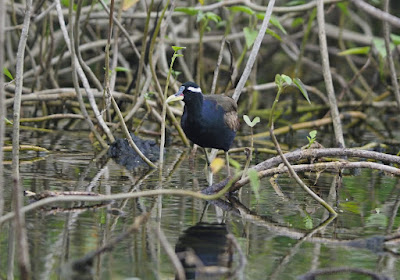One lockdown passed by quickly and another followed in 2021 but lessons learnt in the previous year made me a little bolder and more inquisitive.
A bereavement in the family meant I was again stepping out regularly despite the restrictions and I had many an opportunity to stop at the pond where I had seen the whistling duck and jacanas raise a family.
13th to 17th June, 2021
My old friends were there. The whistling ducks, jacanas and a pair of Eurasian moorhens already seemed to be busy courting again. The onset of the monsoon had set the mood and it was time for romance under the rain. If Raj Kapoor were alive, he'd have material for a movie!
 |
| Lesser whistling ducks |
 |
| Bronze-winged jacana |
 |
| Eurasian moorhens courting |
In another corner of the pond a slight movement caught my eye. On a mound of vegetation, natural or created, I didn't know; there was some frenzied activity going on. Two little grebes were preparing to start a family. This, then, was going to be an unforgettable monsoon for me!
Little grebes (Tachybaptus ruficollis) or dabchicks are, as their name suggests, little. Being the smallest species of the grebe family, they are around 10 inches from the tip of their bills to the virtually non-existent tail. Found in open water bodies with vegetation, they are plump little birds always busy swimming around, diving underwater in pursuit of food and then surfacing a considerable distance away.
 |
| Dive ready |
 |
| Going.... |
 |
| ....going.... |
 |
| ....going.... |
 |
| ....gone! |
 |
| Back again! |
They are designed for swimming and diving. Their short legs are placed far behind on their bodies and therefore they are not good for walking but make their mobility in water effortlessly excellent. While they are well adapted for a life in water, they are reluctant to use their wings. Even if alarmed, they will dive and re-surface at another part of the waterbody instead of flying. To take off, like many water birds, they need a running start and once airborne they can fly for reasonably long distances. This option is used when they migrate between waterbodies.
 |
| Little grebe - nest building |
They build nests on a raised or floating platform of aquatic plants and weeds that are anchored to the reeds or underlying plants. These nests are usually located at the edges of the waterbody and during nest building, more than one site maybe worked upon, before one of them is finalized for egg laying. A nest, floating or otherwise, will be about half a meter in diameter and few inches high.
When I saw my pair of grebes the first time I wasn't sure if the eggs were already laid. They were busy bringing weeds and packing the nest's edges. Some bits were being used to line the central part. Whether it was part of ongoing nest construction or to conceal the eggs, I didn't know. Grebes usually cover the eggs with vegetation before leaving to forage. Perhaps, there were eggs that I couldn't see. One or the other was getting onto the nest and lying on it. That indicated to me that incubation was going on.
 |
| Your turn darling! |
In the last photograph above, the whitish things seen at the top edge of the nest seemed to be the eggs. I wasn't sure but the behaviour of the pair seemed to suggest that it was incubation stage in progress.
Meanwhile the moorhens were also busy courting and one of them also seemed to be in a nest.
 |
| Moorhen in nest |
However, both of them seemed prone to spend more time outside the nest than on it. They were busy all around the pond, not just in the vicinity of the nest. Maybe the eggs weren't laid yet.
Last year's survivor was also in the pond, looking rather forlorn as any attempt to get close to the adult birds resulted in a rather stern response from the parents.
 |
| Immature moorhen |
All this mattered little to the grebes. They had a family to bring up so they were busy taking turns at the nest. Either of them would make forays into the water to collect fresh material for the nest.
Even if they did leave the nest, it wasn't for very long and never too far from it.
They were back quickly to resume the task of incubation.
I knew that I wouldn't have to wait very long. Average incubation period for little grebes are about three weeks or slightly more and if the eggs had been laid few days before I discovered this pair, I would see my first chicks very soon. It was just a matter of patience and dear reader, that goes for you too.
The eggs will hatch in the next episode!
Meanwhile, enjoy this video!




















































